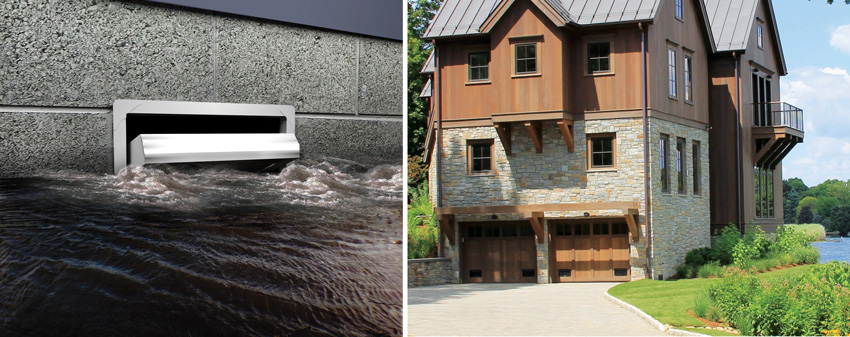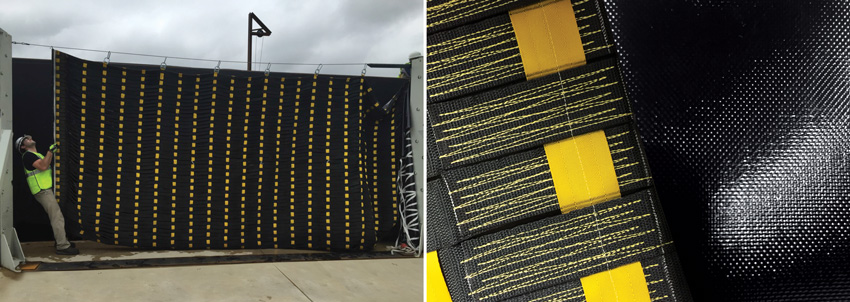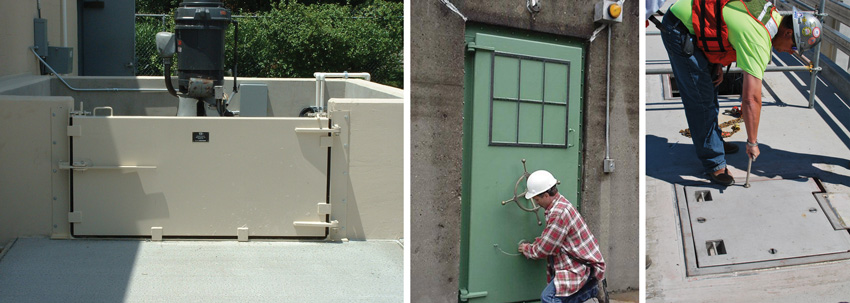Exploring Resilient Building Design
Floodwater Resilience
One of the most devastating and destructive environmental conditions is flooding. Whether caused by heavy rainstorms, hurricanes, or upstream conditions along rivers, buildings and people either need to be protected from floodwaters or buildings need to be designed to withstand the forces of water around the foundation and lower levels. We will look at three different design strategies for addressing flooding hazards.
Wet Flood Proofing with Operable Vents
The primary structural stresses responsible for flood damage on buildings comes from horizontal hydrostatic pressure that builds up on the outside of enclosure walls, thus pushing the walls inward. There may also be some vertical buoyancy forces on the foundation or first floor seeking to lift or float the building. This is compounded in buildings with enclosed sub-grade space, such as a finished basement, where saturated soil hydrostatic pressures and greater buoyancy forces under the basement floor can cause both lifting and collapse of a building.
Recognizing the significance of these hydrostatic forces, codes and regulations require mitigation efforts in the design and construction of buildings in flood zones. Specifically, all new construction and substantial improvements of fully enclosed areas (including crawl spaces and garages) below the lowest occupied floor that are subject to flooding must be designed to automatically equalize hydrostatic flood forces on exterior walls by allowing for both the entry and exit of floodwaters. (Note that new construction in Special Flood Hazard Areas (SFHA) designated by the Federal Emergency Management Agency [FEMA] does not allow for basements [i.e., enclosures that are below grade on all four sides]. Referred to as wet floodproofing, this strategy focuses on designing walls not to resist the hydrostatic pressure but to offset it by allowing water to flow into the enclosed space and create equalized pressure on both sides of the wall. This is a requirement whether the space is used for parking of vehicles, building access, storage, or any other function. Taken to the extreme, this approach would provide no walls at all, just “stilts” or piers that support the building and allow the water to freely pass under the first floor and around the supporting structure. While that may be appropriate for some design situations, it isn’t for all.
For enclosed areas such as crawl spaces, proper flood openings, also called flood vents, need to allow for the automatic entry and exit of floodwater without human intervention, regardless of the direction of flow of that floodwater. In the case of water entering slowly, that flow into an enclosure can cause outward pressure on an opposite or adjacent wall so water needs to flow out as easily as it flows in. Further, debris is a fact of floods, and it’s something that the design of a flood opening needs to address so the debris passes through the opening and doesn’t clog it. To be fully effective, flood vents must be installed in at least two different walls. Further, the bottom of all openings must be within 12 inches of the highest adjacent grade directly below the opening to allow no more than 1 foot of head.
FEMA’s Technical Bulletin 1 states that mass-produced, engineered flood openings must have an ICC-ES certification through the International Code Council’s Evaluation Service. Other characteristics of ICC-ES engineered flood openings are that they must mechanically open during a flood event from a latched, closed position to provide rodent resistance, and they must allow for a 3-inch-diameter sphere to be able to pass though the vent, when in the open position, to allow for flood debris flow. Full requirements can be found in the ICC-ES Acceptance Criteria for Mechanically Operated Flood Vent (AC364).

Images courtesy of Smart Vent Products, Inc.
Flood vents, whether located in foundation walls as shown on the left or in garage doors as shown on the right, allow for wet flood proofing of buildings to equalize water pressure on both sides of a structure.
Dry Flood Proofing with Flexible Systems
Not all buildings or other structures have floor levels or conditions where wet flood proofing is appropriate (i.e., commercial space at grade level). An alternative approach is to set up a barrier around all or part of a building to protect it from rising floodwaters. Piling up sandbags is sometimes reported on the news as one way to do that, but it is time consuming and not necessarily fully effective. For new construction, this technique is not acceptable or compliant. Building walls in new construction are required to have the structural strength to withstand the flood loads. Openings in those walls, such as doors and windows, need some type of additional flood protection to maintain that structural integrity across those openings. Existing buildings can use perimeter-type systems around the whole building. For either situation, new technology allows for a grade-level floor or opening to be protected using flexible barriers that offer versatility and resiliency. This strategy allows for a flexible, high-tech fabric to serve as a flood mitigation system, with everything needed stored at the point of use at the building or the opening. Because of the flexible nature of the materials, very little space is needed, and with some simple design accommodations, it can be stored virtually unnoticed. Then when it is needed due to a flood threat, the flexible system can be deployed rapidly by building maintenance or security staff. Systems are available that are scalable for different design settings, offer robust construction, and use advanced materials.
Brian Shaw, CFM, director of sales and marketing with Smart Vent Products Inc., points out how the construction products industry has evolved in its thinking. “From recent flooding events, we’ve learned about the importance of deployment time for infrastructure flood protection systems,” he says. “The devastating damage and economic loss totals, as well as the loss of life, from Superstorm Sandy showed us that current flood proofing techniques can be useless if they are not deployed in time. The new concept of dry flood proofing using flexible soft goods stored at the point of use for rapid deployment and retraction with minimal man power addresses these issues.” Products like these support architects with flood-proofing solutions that combine aesthetics with engineered and proven performance. They can also help ensure that nonresidential structures located in flood zones are flood resilient, while also providing the lowest flood insurance premium.


Images courtesy of Smart Vent Products, Inc.
Flexible dry flood proofing systems offer rapid deployment and point-of-use storage of the system that can be readily designed into a building.
Rigid Flood Barriers
Commercial and institutional buildings have often relied on rigid flood barrier systems to protect their facilities, the contents inside, and the people who work or visit there. Such systems can take the form of permanent or removable barrier walls that are constructed to be a watertight line between floodwaters and the vulnerable parts of a building. It can also take the form of doors and hatches that are specifically designed to seal openings from water and air infiltration. The technology for these systems has been traditionally based on the same techniques used for marine doors and hatches on ships. Under this approach, individual metal (i.e., aluminum or steel) components are sized to fit with others and then perimeter gaskets are engaged by mechanical or other means to create a watertight seal. Manufacturers of such systems can customize each aspect of the visible components of the design so that they are architecturally minimized from view. These rigid barriers and watertight door have been used in residences, businesses, nuclear power plants, drill rigs, and even navy vessels.
Products of this nature that are useful for flood proofing buildings can be broken down into three main categories: flood barriers, watertight and airtight doors, and watertight hatches. Each is discussed further as follows.
- Flood barriers are designed to seal an opening on three sides (along the bottom and up the sides of the frame) up to a specific height. The top is not sealed; the barrier seals to a specific height of the opening only. This height is usually based on the established flood elevation, plus at least 12 inches. By not sealing to the entire height of the opening, considerable cost savings can be achieved.
A typical rigid flood barrier is made up of a series of panels that can be removable or permanently installed, and are available in single-panel or multiple-panel configurations. Flood barriers are usually manually installed and operated. As a specialty product, all types of flood barriers can be specified to meet standards of federal agencies and code requirements.
Within this category of flood barrier protection, there are some specific types. Removable flood barriers are best used when flooding occurs with some advance warning. Typically, they are stored at the facility or nearby and can be moved into place and assembled by a maintenance or specialty crew in advance of a predicted flood event. A particularly cost-effective version uses stackable, modular “logs” or other components that are well suited for long perimeter protection. Permanent flood barriers can similarly take on several forms. Hinged flood barriers that act as movable portions of walls can be permanently attached to a building opening on either the side or bottom of the opening. Since everything is already in place, they can be closed with very little notice to protect the building from floodwater intrusion. Similar versions are available using panels that slide either horizontally or vertically into place from a permanent stored position. This type is particularly well suited for locations where space constraints exist. Finally, there are also systems which automatically deploy at preset water levels based on floating components that rise ahead of the water level—without any human intervention.
- Watertight and airtight doors are designed to seal all four sides of an opening. They are tested and shown to be 100 percent watertight or airtight, and can be designed for practically any size, any location, and for any pressure requirement. Both manual and power-operated doors are available, and there is now even a watertight roller curtain door that automatically deploys at a preset water level. Most of these doors can also be designed for any number of special design considerations, such as blast, ballistic, shock, vibration, radioactive, seismic, chemical, tornado, and high-pressure requirements. Both single- and double-panel doors are available for most applications.
- Watertight hatches are designed to mount horizontally in either a flush or raised configuration. Using similar technology to watertight doors, they can be designed for any size, location, or pressure requirement. Larger hatches require some type of mechanical assist for opening and closing the hatch panel, such as the use of gas springs, coil springs, counter-weights, or an electrically powered operation. Additional load factors, such as wheel loads and point loads from material-handling equipment, can be readily incorporated into custom designs. Such watertight hatches have been used, for example, as an emergency escape in subway system tunnels.
A key point for architects to be aware of is that there are companies that specialize in this type of equipment and can provide design support beginning in the very early stages of the project. Tom Themel, PE, is vice president of Walz and Krenzer Inc., a flood barrier manufacturer. He relates a very positive collaborative experience working with the Renzo Piano Building Workshop on a project in New York City at the Whitney Museum to help fortify the building’s ability to resist flooding. “Working together, we approached the specific problem with unique solutions that were custom tailored to be sensitive to the architectural design,” he says. Kevin Schorn, an associate with the Renzo Piano Building Workshop, comments, “Their ability to perform complex engineering and invent creative solutions alongside the architects made them an invaluable part of the flood mitigation design team. Their dedication to quality and precise fabrication coupled with their design and engineering skills played a crucial role in safeguarding the Whitney Museum against flooding in the future.”

Photos courtesy of Walz & Krenzer, Inc.
Rigid flood protection can include permanent or removable flood barriers, doors, and hatches that seal tightly against water and air penetration to protect people, equipment, and other valuables.
Notice

www.carlislesyntec.com

www.c-sgroup.com/ejc

RossTechnology.com/CEU

www.smartvent.com

www.stopfloods.com









